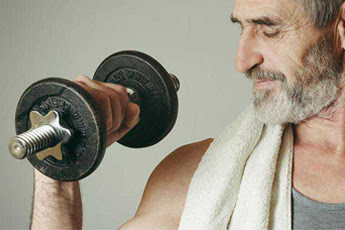Testosterone reverses Muscle Loss due to Aging
By Body Satva Essentials Team www.bodysatva.com
Ageing is associated with Sarcopenia, or loss of muscle mass and strength. An average loss of 12 kg LBM (lean body mass) between the ages of 25 and 70 years and an increase in fat mass of 18-36% over a similar time (Bhasin et al., 1998).[1]
Ageing is associated with Sarcopenia, or loss of muscle mass and strength. An average loss of 12 kg LBM (lean body mass) between the ages of 25 and 70 years and an increase in fat mass of 18-36% over a similar time (Bhasin et al., 1998).[1]
The loss of strength is seen much earlier than loss of muscle mass
and may be accompanied by increasing fat mass. Physiologic age-dependent
changes (drop in growth hormone (GH), IGF-1, (menopause /andropause) explain
the impaired protein synthesis, the decline of muscle mass, strength, and bone
density. Harmful consequences of Sarcopenia in old age are loss of muscle
strength, inducing itself loss of mobility, neuromuscular impairment, and
homeostatic balance failure syndrome with gait and balance disorders.
One factor is the declining levels of Testosterone. Increasing age
is correlated with a rise in SHBG (sex hormone binding globulin) and therefore reduced
free Testosterone. However, in obese men there is a decline in SHBG and
total Testosterone.
Another important factor is insulin resistance or the
diminished response to ‘insulin mediated glucose uptake’. The natural
progression is to endothelial dysfunction, metabolic syndrome, diabetes and
coronary artery disease.
The muscle protein synthesis in response to Insulin is reduced in
elderly people, compared to younger adults. While skeletal muscle is gradually
lost, vascular smooth muscle proliferates and leads to atherosclerosis (thickening
and hardening of arteries).
Defects in energy production by mitochondria (the powerhouse of
the cells) are contributing factors. Aging is known to reduce the DNA
(genetic material) in mitochondria. This in turn results in high amounts of
free radicals which attack proteins and lipids, thus interfering with vital
functions.
Lack of physical activity itself is known to reduce the levels of
Nitric Oxide in the Endothelium (inner lining of blood vessels). This in turn
triggers a cascade of substances known to constrict blood vessels and therefore
reduce the supply of oxygen and nutrition to muscles. Physical activity is
among the best ways to increase Nitric Oxide and restore Endothelial Function.
Aerobic exercise was routinely recommended for cardiovascular
fitness. Recently, both the American Diabetes Association and the American
Heart Association have recommended ‘resistance exercises’
for obese and non-obese diabetic and hypertensive elders.
Muscle mass has been shown to correlate with strength in healthy
older men (Reed et al., 1991), and in turn strength has been shown to
positively correlate with bio-available testosterone (van den Beld et al.,
2000). This has led to interest in the hypothesis that testosterone
supplementation may attenuate or even reverse age-associated Sarcopenia and
enhance the physical strength and well-being of older males.[1]
Various studies have shown that testosterone replacement increases fat free mass and muscle size and strength. As well as decreases in total fat mass, beneficial effects on the distribution of body fat have been reported. Visceral fat (on CT scan) was decreased by 0.4 kg and 0.6 kg (mean) in two studies of overweight men (mean BMI 29 kg/m2) treated for 8 months with oral testosterone (Marin et al., 1992) and 9 months with transdermal testosterone (Marin et al., 1993), respectively.[1]
Older men receiving testosterone increased total and leg LBM (lean body mass), muscle volume, and leg and arm muscle strength after 6 months. LBM accretion resulted from an increase in muscle protein net balance, due to a decrease in muscle protein breakdown. Testosterone treatment increased expression of Androgen Receptor protein at 1 month, but expression returned to pre-Testosterone treatment levels by 6 months. IGF-I protein expression increased at 1 month and remained increased throughout Testosterone administration. Physiological and near-physiological increases of testosterone in older men will increase muscle protein anabolism and muscle strength. [2]
Muscle atrophy in the elderly happens due to a combination of factors like mitochondrial dysfunction, oxidative stress, apoptosis (programmed cell death) and reduction in the synthesis of myosin (the contractile protein of muscles). In a study of the synthesis of myosin heavy chain (MHC) protein over the lifespan and it was found that the rate of MHC synthesis begins decreasing at age 50 before plateauing at age75, and observed a correlation between a decrease in the rate of MHC synthesis and muscle mass, strength measures and, levels of anabolic hormones, including insulin- like growth factor I (IGF-I) and dehydroepiandrosterone sulfate (DHEAS) levels in both men and women and free testosterone level in men. As myosin represents about25–30% of muscle protein, a decrease in its synthesis rate would be expected to impact muscle mass and strength. Human muscle tissue undergoes a fiber-type shift from fast to slow contracting muscle tissue with age. [3]
Various studies have shown that testosterone replacement increases fat free mass and muscle size and strength. As well as decreases in total fat mass, beneficial effects on the distribution of body fat have been reported. Visceral fat (on CT scan) was decreased by 0.4 kg and 0.6 kg (mean) in two studies of overweight men (mean BMI 29 kg/m2) treated for 8 months with oral testosterone (Marin et al., 1992) and 9 months with transdermal testosterone (Marin et al., 1993), respectively.[1]
Older men receiving testosterone increased total and leg LBM (lean body mass), muscle volume, and leg and arm muscle strength after 6 months. LBM accretion resulted from an increase in muscle protein net balance, due to a decrease in muscle protein breakdown. Testosterone treatment increased expression of Androgen Receptor protein at 1 month, but expression returned to pre-Testosterone treatment levels by 6 months. IGF-I protein expression increased at 1 month and remained increased throughout Testosterone administration. Physiological and near-physiological increases of testosterone in older men will increase muscle protein anabolism and muscle strength. [2]
Muscle atrophy in the elderly happens due to a combination of factors like mitochondrial dysfunction, oxidative stress, apoptosis (programmed cell death) and reduction in the synthesis of myosin (the contractile protein of muscles). In a study of the synthesis of myosin heavy chain (MHC) protein over the lifespan and it was found that the rate of MHC synthesis begins decreasing at age 50 before plateauing at age75, and observed a correlation between a decrease in the rate of MHC synthesis and muscle mass, strength measures and, levels of anabolic hormones, including insulin- like growth factor I (IGF-I) and dehydroepiandrosterone sulfate (DHEAS) levels in both men and women and free testosterone level in men. As myosin represents about25–30% of muscle protein, a decrease in its synthesis rate would be expected to impact muscle mass and strength. Human muscle tissue undergoes a fiber-type shift from fast to slow contracting muscle tissue with age. [3]
Exercise has a positive effect on a variety of aging factors and
reduces the risk of heart disease and stroke. Insulin resistance, metabolic
syndrome, muscular atrophy and erectile dysfunction are among the major factors
that are positively impacted by exercise. Improvements in nutrition can improve
muscle protein synthesis and reduce muscle degradation. Include regular
exercise in your schedule to Stay Young.
Prolong Youth by
leading an ‘enlightened and balanced
life’
References:
1) Carolyn AA et al, Clin Endocrinol 60(6):653-670, (2004)
2) Ferrando AA et al, Am J Physiol Endocrinol Metab. 2002; 282(3):E601-7
3) Carla B-Alarcon et al, Frontiers in Endocrinology, Dec2014, Vol 5; Article 217: 1-11
1) Carolyn AA et al, Clin Endocrinol 60(6):653-670, (2004)
2) Ferrando AA et al, Am J Physiol Endocrinol Metab. 2002; 282(3):E601-7
3) Carla B-Alarcon et al, Frontiers in Endocrinology, Dec2014, Vol 5; Article 217: 1-11
Disclaimer
Body
Satva Essentials’ Team has taken maximum care to ensure authenticity of the
information provided, by sourcing from reputed medical journals and books. Body
Satva Essentials’ Team urges members to seek professional advice before
commencing any regimen of diet, exercise and medication.



Comments
Post a Comment